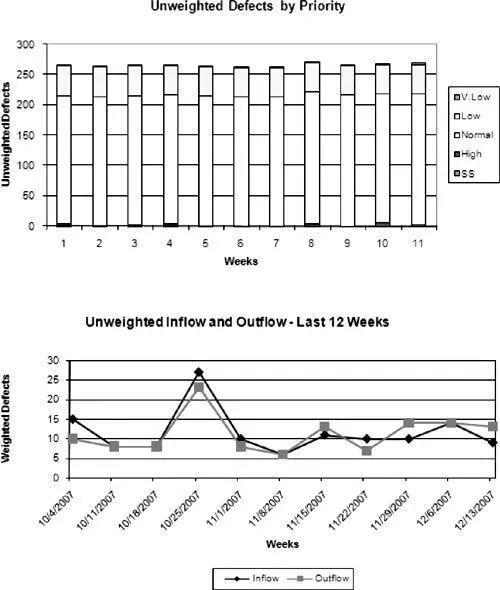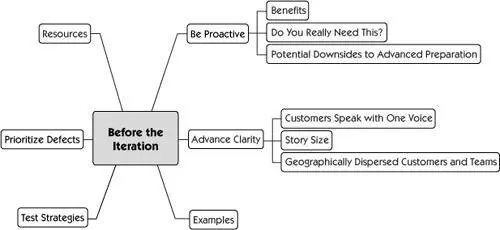Crispin, Lisa - Agile Testing - A Practical Guide for Testers and Agile Teams
Здесь есть возможность читать онлайн «Crispin, Lisa - Agile Testing - A Practical Guide for Testers and Agile Teams» весь текст электронной книги совершенно бесплатно (целиком полную версию без сокращений). В некоторых случаях можно слушать аудио, скачать через торрент в формате fb2 и присутствует краткое содержание. Год выпуска: 2008, Издательство: Addison-Wesley Professional, Жанр: Старинная литература, на английском языке. Описание произведения, (предисловие) а так же отзывы посетителей доступны на портале библиотеки ЛибКат.
- Название:Agile Testing: A Practical Guide for Testers and Agile Teams
- Автор:
- Издательство:Addison-Wesley Professional
- Жанр:
- Год:2008
- ISBN:нет данных
- Рейтинг книги:4 / 5. Голосов: 1
-
Избранное:Добавить в избранное
- Отзывы:
-
Ваша оценка:
- 80
- 1
- 2
- 3
- 4
- 5
Agile Testing: A Practical Guide for Testers and Agile Teams: краткое содержание, описание и аннотация
Предлагаем к чтению аннотацию, описание, краткое содержание или предисловие (зависит от того, что написал сам автор книги «Agile Testing: A Practical Guide for Testers and Agile Teams»). Если вы не нашли необходимую информацию о книге — напишите в комментариях, мы постараемся отыскать её.
Agile Testing: A Practical Guide for Testers and Agile Teams — читать онлайн бесплатно полную книгу (весь текст) целиком
Ниже представлен текст книги, разбитый по страницам. Система сохранения места последней прочитанной страницы, позволяет с удобством читать онлайн бесплатно книгу «Agile Testing: A Practical Guide for Testers and Agile Teams», без необходимости каждый раз заново искать на чём Вы остановились. Поставьте закладку, и сможете в любой момент перейти на страницу, на которой закончили чтение.
Интервал:
Закладка:
Code coverage is just one small part of the puzzle. Use it as such. It doesn’t tell you how good your tests are but only if a certain chunk of code was run during the test. It does not tell you if different paths through the application were run, either. Understand your application and try identifying your highest risk areas, and set a coverage goal that is higher for those areas than for low-risk areas. Don’t forget to include your functional tests in the coverage report as well.
Defect Metrics
As your team sets goals related to defects, use appropriate metrics to measure progress toward those goals. There are trends that you will want to monitor for the whole release, and there are ones that are iteration-specific. For example, if you’re trying to achieve zero defects, you may want to track the open bugs at the end of each iteration, or how many bugs were found after development but before release. Most of us are interested in knowing how many defects have been reported after the code is in production, which is something completely different altogether. These issues will tell you after the fact how well your team did on the last release, but not how well you are doing on the current release. They may give you some indication of what processes you need to change to reduce the number of defects. Lisa’s team is more concerned with production defects found in the “new” code that was rewritten in the new architecture. They’re working hard to produce this new code with zero defects, so they need to know how well they’re doing. They expect that bugs will be found fairly often in the legacy system, where only the most critical functionality is covered by automated GUI smoke tests, and there are few automated unit and behind-the-GUI tests.
Knowing the defect rate of legacy code might be good justification for refactoring or rewriting it, but the team’s top priority is doing a good job with the new code, so they group bugs by “new” and “old” code, and focus on the “new” bugs.
Make sure your bug database can track what you want to measure. You may have to make some changes in both the database and your process to get the data you need. For example, if you want to measure how many defects were found in production after a release, you have to make sure you have environment and version as mandatory fields, or make sure that people who enter bugs always fill them in.
More on defect tracking systems can be found in Chapter 5, “Transitioning Traditional Processes.”
Because defect tracking systems are often used for purposes besides tracking bugs, be sure not to muddle the numbers. A request for a manual update to the database doesn’t necessarily reflect an issue with the existing code. Use your defect tracking tool properly to ensure that your metrics are meaningful.
Lisa’s Story
Periodically evaluate the metrics you’re reporting and see if they’re still relevant. Figure 15-14 shows two defect reports that Lisa’s team used for years. When we first transitioned to agile, managers and others looked at these reports to see the progress that resulted from the new process. Four years later, our ScrumMaster found that nobody was reading these reports anymore, so we quit producing them. By that time, rates of new defects had reduced dramatically, and nobody really cared about the old defects still hanging about in the legacy code.
—Lisa
Figure 15-14 Sample defect reports used (and no longer used) by Lisa’s team

Release planning is a good time to evaluate the ROI of the metrics you’ve been tracking. How much effort are you spending to gather and report the metrics? Do they tell you what you need to know? Does the code you release meet your team’s standards for internal quality? Is the code coverage percentage going up? Is the team meeting its goals for reducing the number of defects that get out to production? If not, was there a good reason?
Metrics are just one piece of the puzzle. Use your release, theme, or project planning meetings to refocus on delivering business value when the business needs it. Take some time to learn about the features you’re about to develop. Don’t get caught up with committing to your plans—the situation is bound to change. Instead, prepare for doing the right activities and getting the right resources in time to meet the customers’ priorities.
Summary
As your team puts together its plan for a new theme or release, keep the main points of this chapter in mind.
 When sizing a story, consider different viewpoints, including business value, risk, technical implementation, and how the feature will be used. Ask clarifying questions, but don’t get bogged down in details.
When sizing a story, consider different viewpoints, including business value, risk, technical implementation, and how the feature will be used. Ask clarifying questions, but don’t get bogged down in details.
 Testers can help identify the “thin slice” or “critical path” through a feature set to help prioritize stories. Schedule high-risk stories early if they might require extra testing early.
Testers can help identify the “thin slice” or “critical path” through a feature set to help prioritize stories. Schedule high-risk stories early if they might require extra testing early.
 The size of testing effort for a story helps determine whether that story is in scope for the release.
The size of testing effort for a story helps determine whether that story is in scope for the release.
 Testers can help the team think about how new stories will impact the larger system.
Testers can help the team think about how new stories will impact the larger system.
 Plan for extra testing time and resources when features may affect systems or subsystems developed by outside teams.
Plan for extra testing time and resources when features may affect systems or subsystems developed by outside teams.
 As the team identifies the scope of the release, evaluate the scope of testing and budget enough time and resources for it.
As the team identifies the scope of the release, evaluate the scope of testing and budget enough time and resources for it.
 Spend some time during release planning to address infrastructure, test environment, and test data concerns.
Spend some time during release planning to address infrastructure, test environment, and test data concerns.
 A lightweight, agile test plan can help make sure all of the testing considerations are addressed during the life of the release or project.
A lightweight, agile test plan can help make sure all of the testing considerations are addressed during the life of the release or project.
 Consider alternatives to test plans that might be more appropriate for your team; test matrices, spreadsheets, or even a whiteboard may be sufficient.
Consider alternatives to test plans that might be more appropriate for your team; test matrices, spreadsheets, or even a whiteboard may be sufficient.
 Formal release planning may not be appropriate for your situation. In the absence of release planning, consider identifying and discussing at least the first few stories that should be done first.
Formal release planning may not be appropriate for your situation. In the absence of release planning, consider identifying and discussing at least the first few stories that should be done first.
 Plan for what metrics you want to capture for the life of the release; think about what problem you are trying to solve and capture only those metrics that are meaningful for your team.
Plan for what metrics you want to capture for the life of the release; think about what problem you are trying to solve and capture only those metrics that are meaningful for your team.
Chapter 16 Hit the Ground Running

In agile development, we generally like to do tasks “just in time.” We can’t see around the curves in the road ahead, so we focus on the activities at hand. Then again, we want to hit the ground running when we start each new iteration. That may require a little preparation. Baking is a good analogy here. You decide you want to bake cookies because someone is coming over. Before you start, you make sure you have the right ingredients. If you don’t, you either go buy what you need, or you choose a different kind to make.
Читать дальшеИнтервал:
Закладка:
Похожие книги на «Agile Testing: A Practical Guide for Testers and Agile Teams»
Представляем Вашему вниманию похожие книги на «Agile Testing: A Practical Guide for Testers and Agile Teams» списком для выбора. Мы отобрали схожую по названию и смыслу литературу в надежде предоставить читателям больше вариантов отыскать новые, интересные, ещё непрочитанные произведения.
Обсуждение, отзывы о книге «Agile Testing: A Practical Guide for Testers and Agile Teams» и просто собственные мнения читателей. Оставьте ваши комментарии, напишите, что Вы думаете о произведении, его смысле или главных героях. Укажите что конкретно понравилось, а что нет, и почему Вы так считаете.












